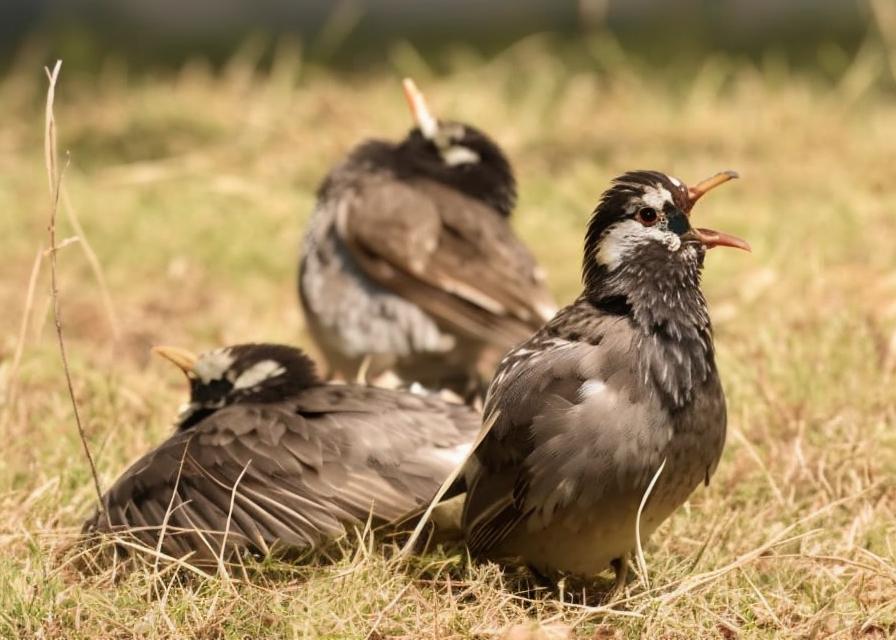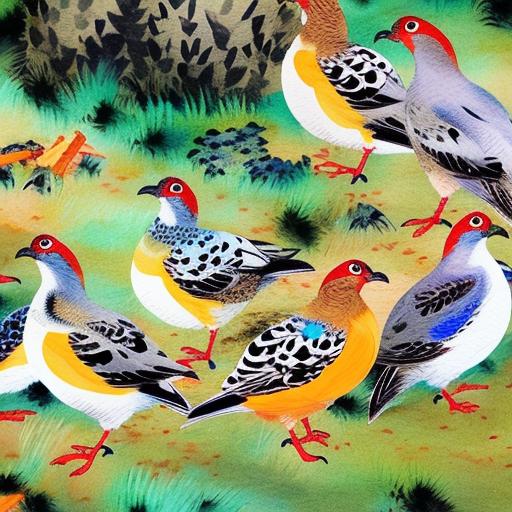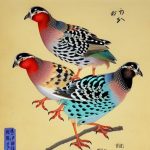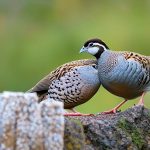Japanese quail, also known as Coturnix quail, are popular birds for breeding due to their small size, fast growth, and high egg production. Breeding Japanese quail can be a rewarding and profitable venture for those interested in poultry farming. These birds are relatively easy to care for and can be raised in small spaces, making them an ideal choice for backyard breeders and commercial operations alike.
Japanese quail come in a variety of colors, including white, brown, and tuxedo, making them an attractive addition to any farm or backyard. They are also known for their gentle nature and quiet disposition, making them a great choice for those who live in urban or suburban areas. Whether you are interested in breeding quail for meat or eggs, or simply enjoy the company of these charming birds, Japanese quail breeding can be a fulfilling hobby or a profitable business venture.
Key Takeaways
- Japanese quail breeding is a rewarding and relatively easy process that can be done on a small scale.
- Selecting healthy breeding stock and providing proper care is essential for successful quail breeding.
- Creating the ideal breeding environment involves providing adequate space, proper nutrition, and a suitable nesting area for the quail.
- Understanding the breeding process, including mating behavior and egg laying, is important for maximizing breeding success.
- Incubating and hatching quail eggs requires careful temperature and humidity control, as well as regular turning of the eggs.
Selecting and Caring for Breeding Stock
When starting a Japanese quail breeding operation, it is important to select healthy breeding stock. Look for birds that are active, alert, and free from any signs of illness or injury. It is also important to choose birds that are of breeding age, which is typically around 6-8 weeks old. When selecting breeding stock, consider the traits you want to pass on to future generations, such as egg production, meat quality, or coloration.
Once you have selected your breeding stock, it is important to provide them with proper care and nutrition. Ensure that they have access to clean water at all times and provide them with a balanced diet that includes a high-quality quail feed. It is also important to provide them with a clean and comfortable living environment, with plenty of space to move around and access to fresh air and natural light. Regular health checks and vaccinations can help prevent the spread of disease and ensure the overall well-being of your breeding stock.
Creating the Ideal Breeding Environment
Creating the ideal breeding environment for Japanese quail is essential for successful breeding and egg production. Quail are sensitive to changes in their environment, so it is important to provide them with a stable and stress-free living space. This can be achieved by providing them with a clean and well-ventilated coop or cage that is free from drafts and extreme temperatures. It is also important to provide them with nesting boxes or areas where they can lay their eggs in privacy.
In addition to a comfortable living space, it is important to provide your breeding quail with the right lighting conditions. Quail are sensitive to changes in daylight length, so it is important to provide them with a consistent light cycle to encourage egg production. This can be achieved by providing them with 14-16 hours of light per day using artificial lighting. It is also important to provide them with a dark period of 8-10 hours per day to mimic natural daylight cycles.
Understanding the Breeding Process
Understanding the breeding process of Japanese quail is essential for successful breeding and egg production. Quail are prolific layers, with hens laying an average of 250-300 eggs per year. Breeding typically occurs when hens reach sexual maturity at around 6-8 weeks old. During the breeding season, hens will lay eggs every 1-2 days, with peak egg production occurring in the spring and summer months.
To encourage successful breeding, it is important to provide your quail with a balanced diet that includes a high-quality quail feed and access to clean water at all times. It is also important to provide them with a comfortable living environment that is free from stress and disturbances. Additionally, providing them with a consistent light cycle can help stimulate egg production and encourage successful breeding.
Incubating and Hatching Quail Eggs
Incubating and hatching quail eggs is an essential part of the breeding process for Japanese quail. Once your hens have laid their eggs, it is important to collect them daily and store them in a cool, dry place until you are ready to incubate them. Quail eggs typically take 17-18 days to hatch, so it is important to carefully monitor the temperature and humidity levels in your incubator to ensure successful hatching.
When incubating quail eggs, it is important to maintain a consistent temperature of around 99.5 degrees Fahrenheit and a humidity level of around 60-70%. It is also important to turn the eggs several times a day to ensure that the embryos develop properly. Once the eggs have hatched, it is important to provide the chicks with a warm and safe environment, with access to clean water and a high-quality chick starter feed.
Raising and Caring for Quail Chicks

Raising and caring for quail chicks requires careful attention to their nutritional and environmental needs. Quail chicks are delicate and require a warm and safe environment to thrive. It is important to provide them with a brooder that is heated to around 95 degrees Fahrenheit for the first week of their lives, gradually decreasing the temperature by 5 degrees each week until they are fully feathered.
In addition to providing them with a warm environment, it is important to provide quail chicks with a balanced diet that includes a high-quality chick starter feed and access to clean water at all times. It is also important to monitor their health closely and provide them with any necessary vaccinations or medications to prevent the spread of disease. As they grow, it is important to gradually introduce them to their outdoor living space, providing them with access to fresh air and natural light.
Tips for Successful Japanese Quail Breeding
Successful Japanese quail breeding requires careful attention to the needs of your birds and their living environment. Providing your breeding stock with proper care and nutrition is essential for successful breeding and egg production. It is also important to create the ideal breeding environment by providing them with a clean and comfortable living space, consistent lighting conditions, and nesting areas for laying eggs.
Understanding the breeding process of Japanese quail is essential for successful breeding and egg production. Providing your quail with a balanced diet, consistent lighting conditions, and a stress-free living environment can help stimulate egg production and encourage successful breeding. Additionally, carefully monitoring the temperature and humidity levels during incubation can help ensure successful hatching of quail eggs.
Raising and caring for quail chicks requires careful attention to their nutritional and environmental needs. Providing them with a warm and safe environment, a balanced diet, and access to clean water at all times is essential for their growth and development. As they grow, gradually introducing them to their outdoor living space can help prepare them for life as adult quail. By following these tips for successful Japanese quail breeding, you can enjoy the rewards of raising these charming birds for meat or eggs, or simply as delightful companions on your farm or homestead.
If you’re interested in Japanese quail breeding, you may also want to explore the topic of chicken coop interior ideas. Creating a comfortable and functional living space for your quails is essential for successful breeding. Check out this insightful article on chicken coop interior ideas to get inspiration for designing a suitable environment for your quails.
FAQs
What is Japanese quail breeding?
Japanese quail breeding refers to the process of raising and breeding Japanese quail, also known as Coturnix japonica, for their eggs, meat, or as pets. This involves providing the necessary care, housing, and nutrition to ensure the health and productivity of the quail.
What are the benefits of Japanese quail breeding?
Breeding Japanese quail can provide a sustainable source of eggs and meat for consumption. Additionally, quail breeding can be a profitable venture for those interested in selling quail eggs or meat. Quail breeding can also be a rewarding hobby for those interested in raising and caring for these birds.
What are the basic requirements for breeding Japanese quail?
Basic requirements for breeding Japanese quail include suitable housing, proper nutrition, access to clean water, and a suitable breeding environment. Quail also require proper care and management to ensure their health and productivity.
What is the ideal breeding environment for Japanese quail?
The ideal breeding environment for Japanese quail includes a well-ventilated and clean housing area with proper lighting and temperature control. Quail also require nesting areas and suitable bedding material for egg laying.
What do Japanese quail eat?
Japanese quail are omnivorous and can be fed a diet of commercial quail feed, supplemented with grains, seeds, fruits, and vegetables. It is important to provide a balanced diet to ensure the health and productivity of the quail.
How long does it take for Japanese quail to reach breeding age?
Japanese quail typically reach sexual maturity and breeding age at around 6-8 weeks old. It is important to separate males and females at the appropriate age to prevent early breeding and ensure proper breeding management.
What are some common health issues in Japanese quail breeding?
Common health issues in Japanese quail breeding include respiratory infections, parasites, and nutritional deficiencies. It is important to monitor the health of the quail and provide proper veterinary care when necessary.
Meet Walter, the feathered-friend fanatic of Florida! Nestled in the sunshine state, Walter struts through life with his feathered companions, clucking his way to happiness. With a coop that’s fancier than a five-star hotel, he’s the Don Juan of the chicken world. When he’s not teaching his hens to do the cha-cha, you’ll find him in a heated debate with his prized rooster, Sir Clucks-a-Lot. Walter’s poultry passion is no yolk; he’s the sunny-side-up guy you never knew you needed in your flock of friends!







